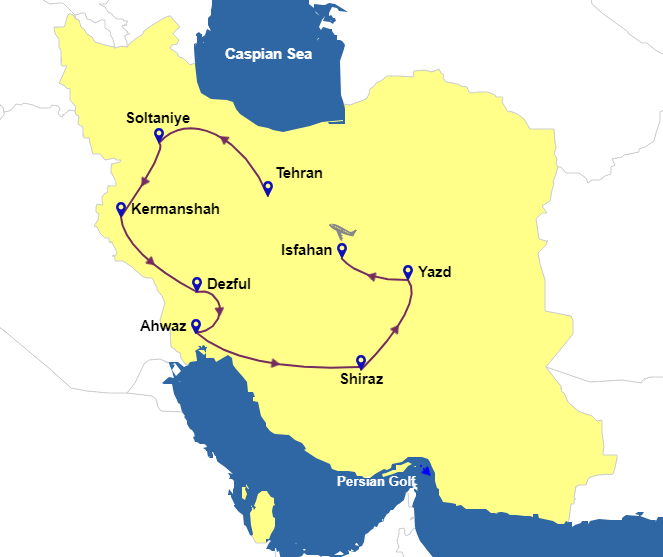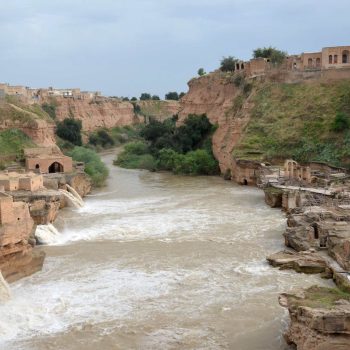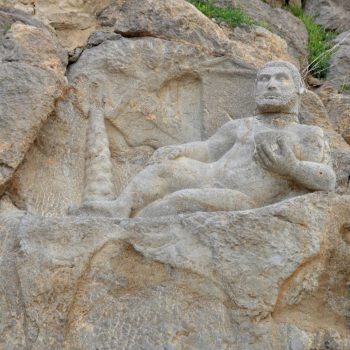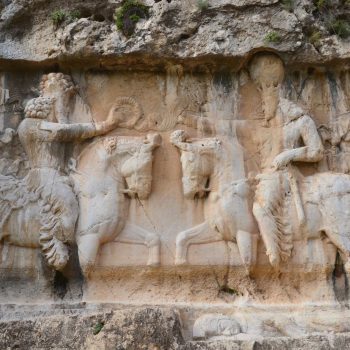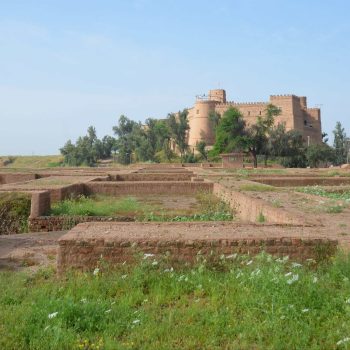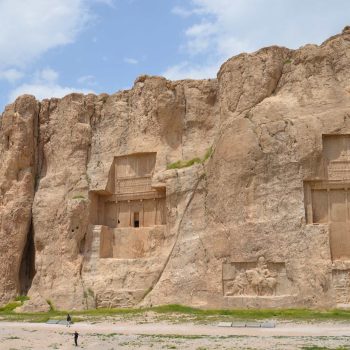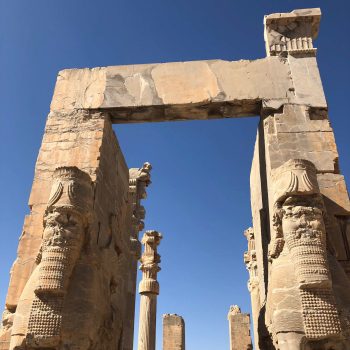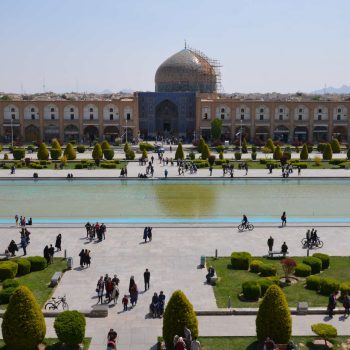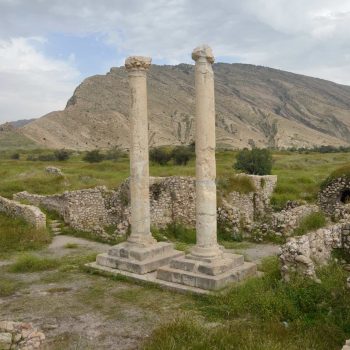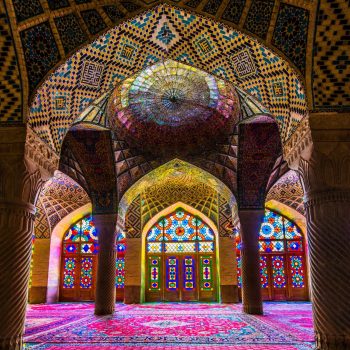Archeology tour of iran
16 Days & 15 Nights
Throughout Archeology tour of iran you will be familiar with art and archaeology of the Persian Empire and its complex interactions with ancient Greece, Mesopotamia, and Egypt . you will also experience daily life of Iranian people .
Highlights of tour
- Two full days in the capital city of Tehran for an introduction to Iran’s archaeology, culture, contemporary art, and history, with visits to several excellent museums, art galleries, and monuments
- Two full days in Isfahan, perhaps Iran’s most splendid city, with glittering, tiled domes that tower above wide, shaded avenues and terraced gardens
- Twelve UNESCO World Heritage Sites:
- Afternoon and morning visits to the astounding site of Persepolis
- Soltaniye’s 14 th -century mausoleum of Mongol Sultan Oljeitu Khodabande
- Bisotun, with a 6th-century bas-relief surrounded by over a thousand lines of inscriptions in Elamite, Babylonian, and Old Persian
- Tehran’s lavish, 18th
- century Golestan Palace
- The Sasanian religious center of Takht-e Soleiman (Solomon’s Throne)
- Susa’s Ardeshir’s Palace and archaeological mounds, whose layers date from the 5th millennium B.C. to the 13th century A.D.
- The Shushtar Historical Hydraulic System, an irrigation system that was begun by Darius the Great in the 5 th century B.C. and completed by the Romans in the 3rd century A.D.
- Isfahan’s immense Meidan Emam (Royal Square) and Masjed-e Jame, one of the world’s greatest mosques
- Choga Zanbil, a 13th -century B.C. Elamite complex with a ziggurat
- Pasargadae, the location of the first Achaemenid capital, with the tomb of Cyrus II and the ruins of gardens, palaces, and altars
- Yazd’s historic center and its traditional, underground irrigation channels (qanats)
DAY 1. Tehran
arrive late at night at Tehran’s Imam Khomeini International Airport (IKA), where you will be met and transferred to our hotel. Overnight at the
DAY 2. Tehran
we visit theArchaeological Collection of the National Museum of Iran,including many famous sculptures of the Achaemenid, Parthian, and Sasanian Empires. After lunch at a local restaurant, we visit the lavish Golestan Palace,a UNESCO World Heritage Site that stands on the site of the historic Arg (citadel) of Tehran. End the day at the Aaran Gallery, one of Tehran’s most important contemporary art galleries. This evening, enjoy a welcome dinner at our hotel.
DAY 3. Tehran
This morning we call at the seldom-visited Sa’d Abad Museum Complex, a former royal estate whose opulent Green Palace houses some of the most beautiful carpets from Iran’s various provinces. After lunch at a local restaurant, continue on to the Reza Abbasi Museum, whose collections focus on art, culture, and technology in Iran from the 2nd millennium B.C. to the early 20th century. Return to the hotel, and then gather to diner at a local restaurant.
DAY 4. Soltaniye | Takht-e Soleiman | Takab
Depart Tehran and drive northwest to Takab (total driving time 7 to 8 hours), stopping along the way to visit Soltaniye, known for its mausoleum of the Mongol Sultan Oljeitu Khodabande. Admire this UNESCO World Heritage Site’s magnificent 14th-century tomb tower, whose decorations and patterns carved into plastered walls have inspired geometric and floral patterns on Persian textiles. After lunch, take a spectacular drivethrough outliers of the Zagros Mountains to Takht-e Soleiman (Solomon’s Throne),
another UNESCO World Heritage Site and once a great Sasanian religious center, where we find the well-preserved remains of a large, fortified settlement built around a small lake on a hilltop. Arrive in Takab, and check-in to the best-available, but very simple, hotel. Overnight at the Ranji Hotel.
DAY 5. Bisotun | Taq-e Bostan | Kermanshah
Depart Takab early this morning and drive to Kermanshah. Make a stop at Bisotun, a UNESCO World Heritage Site whose principle significance is a 6th -century bas-relief ordered by Darius I (“The Great”), below and around which are over a thousand lines of inscriptions, written in three languages (Elamite, Babylonian, and Old Persian). Upon arrival in Kermanshah we have lunch and then visit Taq-e Bostan, where a series of bas-reliefs and grottoes (the latter unique in Sasanian art) were carved into the cliff face.Check-in to our hotel and overnight.
DAY 6. Khoramabad | Falak-ol-Aflak Fortress | Pol-e Dokhtar | Susa | Dezful
Set out for a day of driving to Dezful (six to seven hours total), with stops along the way at several archaeological sites. Our first stop is at Khoramabad, where there are several Paleolithic cave-dwelling sites and views of the Zagros Mountains, which stretch 932 miles and form an imposing backdrop to many of Iran’s towns and cities. Visit Falak-ol-Aflak Fortress, which was built during the Sasanid period, once served as a prison, and today houses one of Iran’s most prestigious anthropology museums.After lunch at a local restaurant we continue driving to Pol-e Dokhtar (“Bridge of the Daughter”), whose eight arches span the River Kashkan. The bridge was part of the Sasanian royal road, which linked the Persian capitals of Istakhr and Bishapur with towns in central and northern Mesopotamia. Continue on to Susa, a UNESCO World Heritage Site comprising archaeological mounds and Ardeshir’s Palace, whose layers of urban settlements date from the late 5th millennium B.C. to the 13th century A.D. Arrive at Dezful, where we check-in to the best-available, but very simple, hotel and have dinner at a local restaurant. Overnight at the Tourist Inn.
DAY 7. Chogha Zanbil | Chogha Mish | Shushtar | ahwaz
Begin the day at the UNESCO World Heritage Site of Chogha Zanbil, a 13th-century B.C. Elamite complex with one of the few extant ziggurats (pyramidal, stepped, tower temples) outside of Mesopotamia. (Please note that due to erosion concerns Chogha Zanbil has recently been fenced, and it is not possible to get close to the site.) Continue on to Chogha Mish, which was a regional center duringMesopotamia’s late Uruk period and is important today as a source of informationabout the development of writing. The site provided evidence of an accounting system that evolved from clay tokens, to clay tablets with marks, to a cuneiform writing system. Drive to Shushtar for lunch at a local restaurant, and then visit the
UNESCO-listed Shushtar Historical Hydraulic System, an irrigation system that was begun by Darius the Great in the 5th century B.C. and completed by the Romans in the 3rd century A.D. overnight in ahwaz.
DAY8. Ahwaz | bishapour | Tang-chogan valley |shiraz
Morning at 0800 am drive to shiraz (539km) on the way we will visit Bishapur (unesco heritage ) which was an ancient city in Sasanid Persia (Iran) on the ancient road between Persis and Elam. The road linked the Sassanid capitals Estakhr (very close to Persepolis) and Ctesiphon.then we will visit Anahita temple which is one of the most famous buildings in ancient city of Bishapur . This cubic structure is about 14 high and was built with clean cut stones attached together with metal staples inspired by Acheamenid architecture in Sassanid period.Just beside the ancient city of Bishapur, there are six bas reliefs of Sassanid Era in Tang-e Chogan valley. Some inscriptions of Sassanid kings on the four corners around a river in this valley are invaluable heritages , then we drive to shiraz and check in at hotel and dinner .
DAY 9. Naqsh-e Rostam | Persepolis | Shiraz: Vakil Bazaar
This morning visit Naqsh-e Rostam, where we find the carved tombs of Achaemenid rulers Darius the Great, Xerxes, Artaxerxes I, and Darius II. After lunch we visit nearby Persepolis, ceremonial capital of the vast Achaemenid Empire. It is perhaps one of the most spectacular surviving archaeological sites in the world, and was designated a UNESCO World Heritage Site. Persepolis comprises about 15 major
ceremonial buildings, including the Apadana, Treasury, and “Harem,” as well as smaller palaces also embellished with sculpture. Return to Shiraz and end the day at Vakil Bazaar, Shiraz’s main bazaar and considered by many to be the finest in Iran.Enjoy dinner at a local restaurant.
DAY 10. Firuzabad | Qal’eh Dokhtar & Palace of Ardashir |Shiraz: Tomb of Hafez
Take a day trip to Firuzabad, formerly known as Gor and Ardashir-Khorra (“Glory of Ardashir”). Firuzabad was the capital of Ardashir I (A.D. 224-241), founder of the Sasanian Empire, and was built in a circular plan more than a mile in diameter and encircled by double walls. A few miles from the old city of Gor is Qal’eh Dokhtar (“The Maiden Castle”), a three-story fortress built by Ardashir I in A.D. 209. In A.D. 224, he built the nearby Palace of Ardashir with a design particular to architects of Fars. Enjoy lunch at a local restaurant, and visit the remains of the Sasanian Tangab Bridge. Return to Shiraz and visit the tomb of the celebrated, 14th-century poet Hafez, whose marble tombstone is engraved with a long verse from his works. Dinner is at a local restaurant.
DAY 11. Pasargadae | Yazd
This morning we drive to Yazd , with stop at Pasargadae, a UNESCO World Heritage Site. Cyrus II (“The Great”) defeated Astyages the Mede nearby in 550 B.C. and Cyrus is said to have built this first Persian capital on the site of his victory. His white limestone tomb stands apart from the scattered ruins of formal gardens, palaces, and altars on a beautiful plain. Upon arriving in Yazd, those who are up to it may climb a steep, dirt path to the spiritual site of the Towers of Silence, where Zoroastrians once laid out their dead. Dinner is at a local restaurant. Overnight at the 4-star Moshir Garden Hotel for two nights.
DAY 12. Yazd walking tour
The architecture of Yazd is perhaps the most traditionally Persian to be found,preserved by the dry climate and spared the devastations of the Mongols. Wind towers are seen all over Iran but are most highly developed in Yazd. Begin exploring Yazd at the home of the city’s former Governor to learn how wind towers work and more about residential Persian architecture in the desert. Take a walking tour through the bazaar, ending at the Water Museum, an excellent introduction to qanats (traditional
underground water channels for irrigation, which have been collectively designated a UNESCO World Heritage Site). After lunch in the old quarter, enjoy a walk through covered streets. End the day concentrating on the Zoroastrian religion, which during Sasanian times was the state creed. There are about 400,000 Zoroastrians left in the world, of which about 60,000 live in and around Yazd. Zoroastrians worship fire as a symbol of God, and keep eternal flames burning at their temples. Visit the Ateshkade, where it is said that a sacred flame has been burning since about A.D. 470. Dinner is at a local restaurant this evening.
DAY 13. TNa’in | Ardestan | Isfahan: Hasht Behesht
This morning we drive to Na’in, an important trade center at the geographical center of Iran that is known for its carpet-making and fine early mosque. After a visit to a private house with some superb, 17th-century stucco carvings, we have lunch at a charming local restaurant. Continue driving to Ardestan, home to a large, 10th-century Seljuk mosque (one of the earliest built on a four-ivan
plan), and near to a 16th-century, carved alabaster tomb of a soldier and early Safavid administrator, Amin Oways, who was killed and buried on the battlefield. Drive onward to Isfahan, arriving
mid-afternoon, and visit the Hasht Behesht, one of the city’s two surviving Safavid pavilions (restored in the 1970s), in the center of the Garden of Nightingales (Bagh-e Bulbul). Check-in to our charming hotel, a converted, double-storied caravanserai of the late Safavid period . Overnight
DAY 14. Isfahan: Palace of Forty Columns, Meidan Emam, Bazaar
Today we begin exploring Isfahan, perhaps the most splendid of all Iranian cities, at the Palace of Forty Columns, a charming pavilion whose walls are covered with frescoes and paintings. Walk to the nearby, immense, Meidan Emam (“Royal Square”), a UNESCO World Heritage Site. Four jewels of 17th-century architecture adorn each side, symbolizing the political, economic, and religious spheres of Safavid Persia. Enjoy lunch at a local restaurant, and spend some time this afternoon exploring the city’s bazaar. Gather this evening for a farewell dinner at a local restaurant.
DAY 15. Isfahan: Friday Mosque, Armenian Quarter,Music Museum| Farewell dinner
This morning visit the complex and magnificent Masjed-e Jame (Friday Mosque), a UNESCO World Heritage Site and truly one of the world’s greatest mosques. Its tiled ivans, vaulted ceilings, and
lofty domes demonstrate more than 800 years of Persian religious architecture. View some of the five bridges crossing the Zayendehrud River (which is often dry, due to drought and construction of a dam).
Perhaps the most beautiful is the two-story, 17th-century Khaju Bridge that is essentially a bridge superimposed upon a dam and supported by 24 stone arches. Continue on to Isfahan’s Armenian quarter, where there are 14 churches, and take a walking tour through its narrow, twisting alleys and streets. End the day with a private, guided tour of the new Music Museum, which houses more than 300 instruments from around Iran (many unchanged for centuries). We have an early farewell dinner and overnight.
DAY 16. Isfahan | Fly home
Transfer very early this morning to Isfahan International Airport (IFN) for departure to your country

